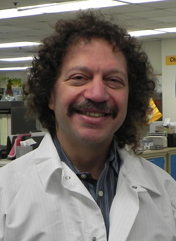
Research Topics
Signaling pathways in cells regulate normal cellular behavior and responses to insults such as infection or wounding. Disruption of the normal homeostatic mechanisms that synchronize intracellular signal transduction leads to diabetes, cancer and disorders of the cardiovascular and immune systems. Ca2+ is a versatile intracellular signaling molecule that modulates diverse cellular processes. The primary mediator of Ca2+-dependent signaling in eukaryotic cells is calmodulin, which serves as a high affinity intracellular Ca2+ receptor. The effects of calmodulin are produced by direct interaction with target proteins, or indirectly via multiple specific kinases. The research in our laboratory is directed towards elucidating the role of calmodulin in several signal transduction pathways. Novel calmodulin targets are studied. The major areas of interest are the disruption of the normal signaling pathways that result in cancer and microbial pathogenesis. A diverse array of biochemical, cell biological, and molecular biological approaches are used in these investigations.
Role of the Calmodulin-binding Protein IQGAP1in Tumorigenesis. IQGAP1 is a multidomain protein that has numerous binding partners. We have identified several interacting proteins, ranging from calmodulin and nuclear factor of activated T cells (NFAT) to the human epidermal growth factor receptor 2 (HER2) and components of the mitogen-activated protein kinase (MAPK) cascade. By interacting with these binding partners, IQGAP1 regulates multiple cellular processes, such as signaling by MAPK, cAMP and Ca2+, phagocytosis, cardiac remodelling and exocytosis. Calmodulin alters the binding of all IQGAP1 target proteins that have been evaluated, thereby modulating cell function. We documented that IQGAP1 promotes cell motility and enhances tumorigenesis of human breast epithelial cells. Patients with HER2-positive breast cancer have a poor prognosis with decreased survival, despite specific therapy with tratuzumab ("herceptin"). We showed that IQGAP1 is overexpressed in HER2-positive breast cancer and knockdown of IQGAP1 decreases HER2 expression, signaling, HER2-stimulated cell proliferation and ameliorates resistance to tratuzumab. Currently, we are identifying other IQGAP1-binding proteins that are expressed at altered levels in carcinoma and are studying their roles in tumorigenesis.
Estrogen Receptor Signaling. The steroid hormone estrogen mediates its biological effects in cells through the estrogen receptor (ER). Calmodulin binds directly to ER in a Ca2+-dependent manner. We documented that calmodulin binding both promotes the stability of ER, by sequestering it away from the ubiquitin-proteasome pathway, and is necessary for estrogen-stimulated transcriptional activity of ER. Our structural analysis reveals that calmodulin binds two molecules of ER in a 1:2 complex, thereby facilitating dimerization of ER. Currently, we are solving additional structures and further elucidating the biology of the interactions.
Role of IQGAP1 in Microbial Pathogenesis. Pathogenic microbes have developed sophisticated mechanisms to enter cells, evade destruction inside the eukaryotic cell and multiply. The cytoskeleton of the host cell is a common target that is manipulated by bacteria to facilitate infection. We observed that IQGAP1 is a component of the cytoskeletal rearrangements by which Salmonella enters cells. Interestingly, Salmonella entry into host cells was significantly increased and decreased by IQGAP1 knockdown and overexpression, respectively. Enteropathogenic Escherichia coli (EPEC) also usurps IQGAP1 to infect host cells. Studies elucidating the molecular mechanisms by which Salmonella usurps IQGAP1 function and exploring the possible participation of IQGAP1 in the pathogenesis of other microbes are in progress.
Biography
Dr. Sacks received his medical training at the University of Cape Town in South Africa. He completed residencies in internal medicine at Georgetown University affiliated hospitals in Washington, D.C., and in clinical pathology at Washington University School of Medicine in St. Louis, and is board certified in both disciplines. He received fellowship training in clinical chemistry at Washington University School of Medicine. Later he was an associate professor in the Department of Pathology at Harvard Medical School. He joined the NIH as Chief of Clinical Chemistry in 2011.
Selected Publications
- Chawla B, Hedman AC, Sayedyahossein S, Erdemir HH, Li Z, Sacks DB. Absence of IQGAP1 Protein Leads to Insulin Resistance. J Biol Chem. 2017;292(8):3273-3289.
- Smith JM, Hedman AC, Sacks DB. IQGAPs choreograph cellular signaling from the membrane to the nucleus. Trends Cell Biol. 2015;25(3):171-84.
- Jadeski L, Mataraza JM, Jeong HW, Li Z, Sacks DB. IQGAP1 stimulates proliferation and enhances tumorigenesis of human breast epithelial cells. J Biol Chem. 2008;283(2):1008-17.
- Li Z, Zhang Y, Hedman AC, Ames JB, Sacks DB. Calmodulin Lobes Facilitate Dimerization and Activation of Estrogen Receptor-α. J Biol Chem. 2017;292(11):4614-4622.
- Hedman AC, McNulty DE, Li Z, Gorisse L, Annan RS, Sacks DB. Tyrosine phosphorylation of the scaffold protein IQGAP1 in the MET pathway alters function. J Biol Chem. 2020;295(52):18105-18121.
Related Scientific Focus Areas




Molecular Biology and Biochemistry
View additional Principal Investigators in Molecular Biology and Biochemistry
This page was last updated on Thursday, August 14, 2025